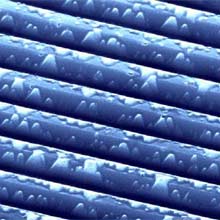The Year in Nanotech
Nano Power
Nanowires and carbon nanotubes are proving valuable for generating and storing energy. Researchers have shown that nanowires can convert vibrations into electricity. (See “Nanogenerator Fueled by Vibrations” and “A New Nanogenerator.”) Other nanowires can generate power from light. (See “Tiny Solar Cells.”) Carbon nanotubes could be useful for extracting more power from cheap solar-cell materials. (See “Cheap Nano Solar Cells.”)

Nanotechnology could also greatly improve batteries. MIT researchers made fibers out of viruses coated with functional materials. The fibers could lead to textiles that collect energy from the sun, convert it into electricity, and store it until it’s needed. (See “Virus-Built Electronics.”) At the end of the year, Stanford researchers published research showing that silicon nanowires can significantly increase the storage capacity of battery electrodes.
Making Objects Invisible
Theorists have predicted a new class of materials that could render objects invisible. The materials work because they interact with light in unusual ways. Now a number of researchers are beginning to put those theories into practice, making rudimentary invisibility cloaks by controlling the micro- and nanostructure of materials. In addition to making things disappear, such materials could be useful for patterning tiny features for computer chips or for novel antennae for communications. (See “Invisible Revolution,” “Superlenses and Smaller Computer Chips,” “How to Make an Object Invisible,” and “Invisibility Made Easier.”)
Materials That Stick to Nothing–or Anything
Teflon pans are easy to clean. But a new super self-cleaning material actually causes oil to bounce off. (See “No More Thumbprints.”) Another material–this one transparent–could be used to keep windows fog and oil free. (See “Self-Cleaning, Fog-Free Windows.”)
Other researchers are developing supersticky materials. They have made structures out of carbon nanotubes that are like the structures on geckos’ feet that allow the lizards to climb walls. They’ve also made glues similar to the proteins that allow mussels to stick to nearly anything, even underwater. (See “Climbing Walls with Nanotubes,” “Nanoglue Sticks Underwater,” and “Glue That Sticks to Nearly Everything.”)
Flexible Electronics Coming to Market
Electronics patterned on flexible substrates that could be used for roll-up displays have previously been demonstrated in the lab. Now products are on the way. In February we described the plans of two companies to manufacture flexible electronics. (See “Plastic Electronics Head for Market.”) One of the companies has now actually started production on a flexible-display device.
Meanwhile, researchers are developing methods for making flexible electronics with higher performance. (See “Printing Cheap Chips” and “Expandable Silicon.”)
Tiny Memory
Novel approaches to storing data could lead to memory chips as much as a hundred times more compact than today’s devices. These include materials that change structure (see “Novel Nanowires for Faster Memory”) and ones that grow atoms-thick wires (see “Terabyte Storage for Cell Phones”) in response to tiny electronic signals. Researchers at IBM are developing memory chips that exploit newly understood physical mechanisms to provide a cheap and fast alternative to hard drives and flash memory. (See “IBM Attempts to Reinvent Memory.”)
Keep Reading
Most Popular
Large language models can do jaw-dropping things. But nobody knows exactly why.
And that's a problem. Figuring it out is one of the biggest scientific puzzles of our time and a crucial step towards controlling more powerful future models.
How scientists traced a mysterious covid case back to six toilets
When wastewater surveillance turns into a hunt for a single infected individual, the ethics get tricky.
The problem with plug-in hybrids? Their drivers.
Plug-in hybrids are often sold as a transition to EVs, but new data from Europe shows we’re still underestimating the emissions they produce.
Stay connected
Get the latest updates from
MIT Technology Review
Discover special offers, top stories, upcoming events, and more.